What is a Cassowary?
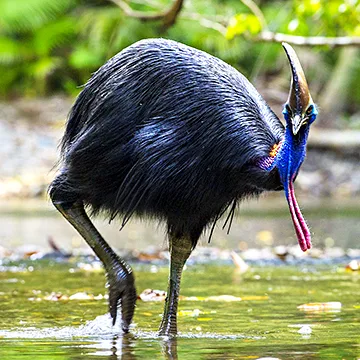
Contents
Cassowary Description
The cassowary is a large, flightless bird known for its dinosaur-like appearance and its extreme aggressive behaviour. It is often called "the world’s most dangerous bird."
Growing over 2 meters tall and weighing up to 59 kg, the cassowary has sleek, black, hair-like feathers, nearly invisible wings with quill-like spines, a striking blue face, and a huge, helmet-like casque on its head. The cassowary can sprint at speeds of 50 kph through dense forests and leap up to 2 meters high. It has muscular legs, each equipped with a large, 10 cm dagger-like claw. Its booming calls, similar to ancient reptilian calls, can be heard echoing through the jungle. The cassowary belongs to a group of flightless birds known as ratites.
Is The Cassowary a Dinosaur?
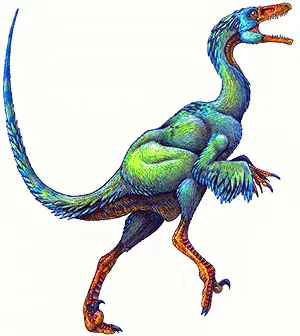
Photo: Cassowary is descendent from dinosaurs
Yes—kind of. All birds are descended from dinosaurs, but cassowaries retain more visible “dino” features than most:
• Helmet-like casque (similar to crests on dinosaurs like the Corythosaurus)
• Scaly legs, two-legged stance, and predatory eyes
• Deep, booming sounds similar to ancient reptilian calls.
• Related Fossils: Scientists have found caenagnathid and dromaeosaurid fossils with traits shared by cassowaries. These dinosaurs shared many characteristics with modern birds, such as feathers, hollow bones, nesting, egg-brooding and care for their young.
So it is reasonable to say cassowaries are probably the closest present-day living relatives of the ancient dinosaurs.
Cassowary Attack with Video
Cassowary Attack Video
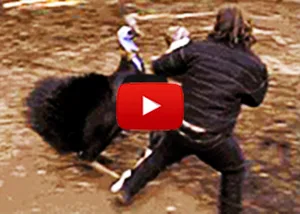
A cassowary is fearless and will attack if it feels threatened. With its powerful legs and sharp 10cm long claws, a cassowary can inflict serious harm on its victim. In fact, cassowaries have been known to chase their victims at speeds of up to 50kph and launch themselves up to 2 meters off the ground to deliver powerful kicks. Nearly 75% of cassowary attacks on humans result from humans trying to feed these animals.
So, beware of the cassowary! Approach with caution and never feed a cassowary.
Cassowary Sounds with Video
Cassowary Sounds Video
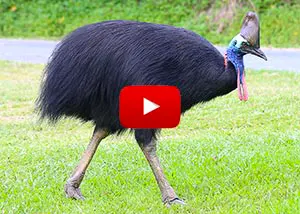
The cassowary produces a deep, low-frequency rumbling and booming sound reaching as low as 32 hertz. It makes these noises by resonating air in its chest and neck and amplifying the sound further with its casque. The cassowary also whistles, hisses, and claps its bills to communicate. A cassowary can pick up these low-frequency calls from other cassowaries over vast distances.
Where Do Cassowaries Live?
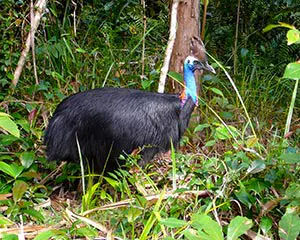
Photo: Cassowary in rainforest
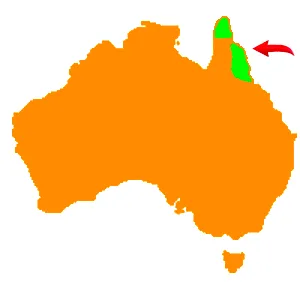
Photo: Cassowary Habitat Map
Cassowaries live in the rainforests of northern Queensland in Australia and in Papua New Guinea (See map).
Each cassowary's home range is approximately 7 square kilometres in size but may vary depending on environmental conditions. They are solitary creatures that tend to be more active during dawn and dusk.
Did You Know:
The cassowary is an excellent swimmer, crossing rivers and even swimming in the ocean. However, it's feathers aren't waterproof like most birds. So after a swim, it shakes its body, much like a dog, to get rid of the water.
What Do Cassowaries Eat?
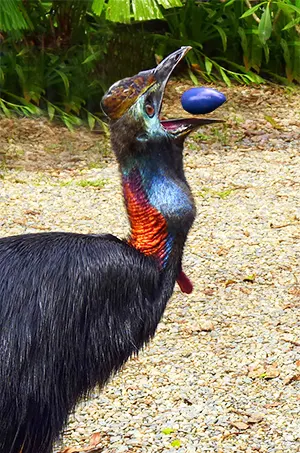
Photo: Cassowary eating a Cassowary Plum
Cassowaries have a relatively primitive digestive system compared to other birds. As a result a cassowary needs up to five kilograms of food a day and consists mainly of:
• Fallen rainforest fruits (like the poisonous Cassowary Plum
• Insects, snails, frogs, snakes, small animals, carrion and fungi.
• The cassowary lacks a tongue: throws food into the back of its throat and swallows whole.
Ecological Role
Cassowary dung, called a “scat”, often contains hundreds, if not thousands, of seeds which help in the dispersal of seeds throughout the forest.
Cassowary Reproduction & Parenting
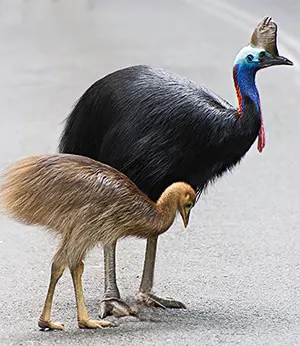
Photo: Cassowary with chick
• Breeding Season: June–November
• Female lays 3–8 large green eggs and then leaves
• Male incubates the eggs (~50 days) and raises chicks for 9 months.
• Chick Survival Rate: Only 1 in 4 usually reaches adulthood
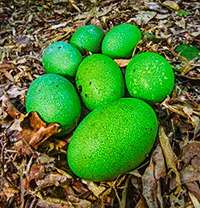
Photo: Cassowary eggs
The chicks are light brown and have stripes that camouflage them very well amongst the leaf litter and protect them from predators. This colouring disappears as the chick grows. Cassowary chicks do not have a casque, which only begins growing in juveniles when their plumage changes. The young chicks make a whistling-peeping sound as they run about. The father may respond by clacking its beak, burping, or even making a booming noise that cassowaries are renowned for. After about nine months, when the chicks can fend for themselves, the father chases them away to go and find their own territory.
The mortality rate amongst cassowary offspring is very high. Usually, only one in each brood survives into adulthood. They reach sexual maturity at about three years. A cassowary lives for up to forty years.
How Did The Cassowary Get its Name?
The word Cassowary is pronounced "cas-so-wary". There are two explanations as to how this cassowary got its name. One is that it is based on the French word "casque" which meaning helmet. The other is that it is from words in the Papuan language - 'kasu' meaning horned and 'weri' meaning head. The second explanation seems more plausible given that this bird is also found in Papua New Guinea.
The cassowary found in Australia is known as the Southern Cassowary or Double-wattled Cassowary. This is to distinguish it from its relatives found on the island of New Guinea, which is referred to as the Single-wattled Cassowary.
Why Does the Cassowary Have Casque (Helmet)?
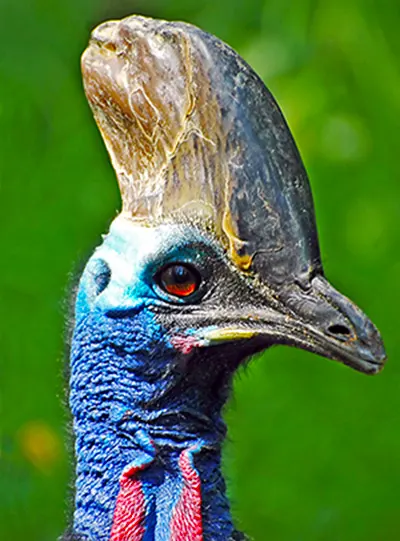
Photo: Cassowary's casque helmet
The casque is a unique horn-like structure made of spongy bone and keratin. Its purpose is still debated:
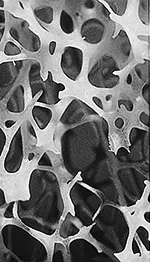
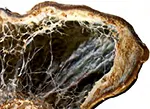
Photo: Inside the Casque
• It's a Crash Helmet to protect its head as it travels through the dense rainforest. probably — unlikely
• It's a Lethal Weapon. There is no evidence that the cassowary uses its head in fighting. — unlikely
• It's a Tool. While the animal may use its head sometimes to knock down low-hanging fruit or to shift leaf litter, using its casque as a tool doesn't seem to be its primary purpose. — unlikely
• It's a Fancy Headdress. The casque and its colourful neck and wattles may be intended to signal dominance, health, and virility. There seems to be some truth in this, similar to how peacocks use their brightly coloured necks and tail feathers.— probably
• It's an Amplifier and Receiver. The cassowary makes a very low-frequency booming sound with the casque acting like a sound-box to modify, amplify, and resonate the bird's sounds. The casque may also act like a radar dish (receiver) assisting in picking up other cassowaries' calls. — probably
• It's a Radiator. Many tropical birds use their beaks and wings to cool themselves. The cassowary has none of these. So when the weather is hot, these blood vessels in the casque dilate, allowing more blood to flow in it, where the air outside cools it. When it's colder, the vessels constrict, restricting the blood supply to the casque.— most likelyConclusion —The most likely reason for the cassowary's casque is to regulate its body temperature. Secondary uses are for display, as an amplifier to generate low-frequency sounds, and as a radar dish to receive calls from other cassowaries.
Cassowary is a Ratite - A Flightless Bird
The Cassowary belongs to a group of flightless birds known as Ratites which also include the Ostrich, Emu, Kiwi, and Rhea. Ratites are different from other birds in that they have a flat breastbone and are mostly large-bodied and terrestrial; they are rather big and don't fly. Because they no longer fly, their wings have shrunk into non-functioning stubs. These birds also have a less sophisticated digestive system than modern birds.
Why is Cassowary Endangered
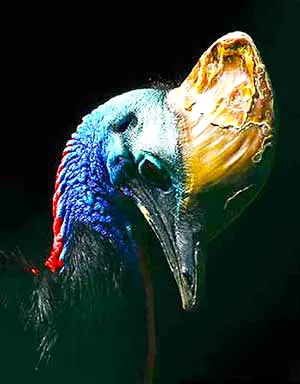
Photo: Cassowary portrait
Cassowaries have no natural predators, however their numbers are declining rapidly. The major reasons for the rapid decline in the number of cassowaries are:
• Habitat loss: Over 80% of original rainforest has been destroyed
• Road deaths: Vehicles kill 50% of known cassowary casualties annually
• Dog attacks: Domestic and feral dogs kill up to 18% of cassowaries
• Feeding by humans: Draws cassowaries into dangerous urban zones
• Feral pigs: Destroy nests and compete for food
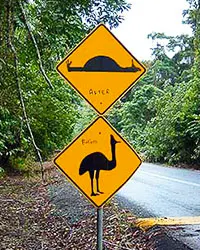
Photo: Cassowary road sign
Cassowary Conservation Status
There are about 20,000-50,0000 Southern Cassowaries left in the wild. Their numbers are declining because of habitat loss. The Australian government lists the southern cassowary as as an endangered animal. These birds are classified as Least Concern (2018) by the IUCN.
25 Fascinating Cassowary Facts
- Cassowaries are flightless birds with dinosaur-like features.
- They live in the rainforests of Australia and Papua New Guinea.
- It is the second-largest bird in the world, growing to 2m and weighing up to 80kg.
- The cassowary is the world’s most dangerous bird.
- It avoids humans but is very brave and will stand its ground if approached.
- It attacks by jumping in the air and kicking with its powerful leg with dagger-like claws.
- 200 or so cassowary attacks are reported in Australia each year, but few deaths.
- A Florida man was killed by a cassowary in 2019. That was nearly 100 years since the previous death.
- The cassowary gets its name from the Papuan language - 'kasu' meaning horned and 'weri' meaning head.
- It is closely related to the emu.
- The cassowary makes a low-frequency booming, rumbling sound that can be heard up to 5km away.
- The cassowary has a large helmet on its head called a Casque.
- This helmet is made of keratin—the same stuff as our fingernails.
- It has been suggested that the casque acts as an amplifier to generate the cassowary's low-frequency sounds and as a radar dish to receive calls from other cassowaries.
- It has tiny wings that have no feathers but have a few long quills.
- It also has no tail feathers.
- A Cassowary is quite agile and can run at 50 kph even through thick forests. It can also jump 2m and can swim. It even swims in the ocean.
- Its diet consists mainly of fruits that have fallen to the rainforest floor.
- It is vital for forest regeneration because some seeds only germinate after passing through the cassowary's gut.
- The cassowary's feathers aren't waterproof. So after a swim, it shakes its body, much like a dog, to get rid of water.
- The female cassowary lays 3-8 huge bright green eggs and then abandons the eggs. The male cassowary incubated the eggs and raises the chicks.
- The colour of the cassowary egg is caused by a pigment called biliverdin found in it bile.
- The cassowary looks like a modern-day dinosaur bird.
- There are only 1,200 Southern cassowaries left in the wild.
- The cassowary may soon become extinct.